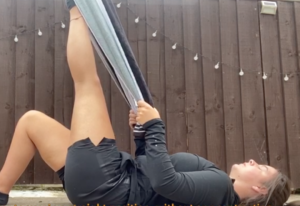Proprioceptive neuromuscular facilitation (PNF) Stretching
What is Proprioceptive Neuromuscular Facilitation (PNF) Stretching?
Proprioceptive neuromuscular facilitation (PNF) stretching techniques is an advanced form of passive stretching to help target muscles and increase range of motion and flexibility of various limbs.
Passive stretching means relaxing the body, applying a mid-comfort felt stretch, while a partner, accessory, or support strengthens the stretch by applying external pressure to the limb for a set time. Once the passive stretch has been applied, a contraction to the muscle group without movement is completed, then relaxed and repeated.
Many of us will hold our hands up and say our flexibility isn’t the greatest…including mine! Despite being involved within an athletic performance or normal daily life, PNF stretching can be very beneficial for those who lack the flexibility to improve muscle length and elasticity. PNF stretching has become a very popular stretching technique over recent years. Positively impacting on flexibility and movement and used by many therapists and individuals themselves. So, here’s a fantastic way of improving flexibility, so why not give this a go!
How does Proprioceptive neuromuscular facilitation (PNF) stretching work?
There are various types of PNF stretching, however, they all contribute towards stretching the muscle. You can achieve this stretching technique passively stretching a muscle group as explained above. Then contracting the muscle without movement or against resistance, whilst performing a stretch. The muscle group is relaxed and passively stretched again, to increase muscle length and elasticity. Then repeat this process a few times, and see a significant difference in flexibility and movement.
Stretching a muscle to its limit will activate the stretch reflex to allow any further contraction of the targeted muscle. Stretch reflex is a signal into the spinal cord and a signal out to the muscle (like a pre-programmed response), activating the muscle contraction in response to the passive stretch. This is also a protective reflex that calms the muscle to prevent injury. In doing so, allows the brain signals to target muscles to relax, in order to continue with the process. For example, long periods of persistent sitting can result in tightness of the hip flexors and hamstrings. In this case, you can consider PNF stretching to improve range of motion and flexibility. Especially, for those who have continued to work at a desk throughout this pandemic.
Benefits
- PNF stretching is known to improve active and passive range of motion, therefore effectively improving flexibility.
- Increasing muscle length and improving the nervous systems ability to target the correct muscles to produce and reduce force.
- This form of stretching also maintains and/or improve muscular strength due to isometric strengthening.
- Although PNF is mainly aimed at stretching muscles, this can improve joint stability.
- This technique can also help to increase neuromuscular control and coordination.
- Known to reduce acute muscular injuries with running, sprinting, or other repetitive contractions.
- People can use PNF stretching for those of all ages.
Types of Proprioceptive neuromuscular facilitation (PNF) stretching
There are various types of PNF stretching, such as hold-relax, contract-relax, and contract-relax with antagonist contraction.
Here is just one of the main PNF stretched commonly used:
Hold-relax
- Lie on your back with your legs and arms on the floor. Hold both ends of a towel and loop the middle around the pad of your foot.
- Lift one leg and begin with a passive pre-stretch, and hold this position at the point of mild discomfort for around 10 seconds.
- Then, push your leg in a straight position into the towel without any movement of the leg. Hold this for 6 seconds
- When the 6 seconds is up, relax stretch and try to pull your leg further than you did on the first stretch for 30 seconds.
- Then, Repeat this process.
In this video, Lauren demonstrates Proprioceptive neuromuscular facilitation stretching
Keywords
Active: When an individual moves their limbs on their own without support.
Passive: Applying a stretch, while a partner, accessory, or support strengthens the stretch by applying external pressure to the limb for a set time.
Isometric contraction: A contraction to the muscle without any movement involved.
Stretch reflex: Stretch reflex is a signal into the spinal cord and a signal out to the muscle, activating the muscle contraction in response to the passive stretch
Antagonist contraction: One muscle of the pair contracts to move the body part, and the opposite muscle group relaxes. For example, lifting the arm…. Agonist: contraction of the bicep and antagonist: relaxation of the triceps.


